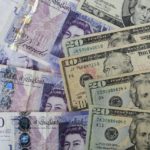Gold declined and was poised to snap five-week rally, the longest since September 2012, on increased bets the Federal Reserve will keep scaling back stimulus as the US economy showed signs of strengthening and as the recent slump in emerging markets eased. The metal drew some support as assets in the SPDR Gold Trust, the biggest bullion-backed ETF, rose for a second day yesterday, after they had been increased for the first time in two weeks the previous day.
On the Comex division of the New York Mercantile Exchange, gold futures for settlement in April fell by 0.1% to trade at $1 241.40 per troy ounce by 08:01 GMT. Prices touched a session high at $1 244.70, while day’s low was touched at $1 240.70 an ounce.
Gold futures settled last 5-day period 1.3% higher, capping a fifth consecutive week of gains, but were set to lose 2.2% this week, the first weekly loss since the period ended December 20. The precious metal settled last year 28% lower, the steepest annual decline since 1981 as investors lost faith in the metal as a store of value and amid speculation Fed will continue scaling back its monetary stimulus throughout 2014.
Golds demand as a haven was fueled earlier in the week amid a slump in emerging-market currencies.
However, the metal dropped “as previous safe-haven buying possibly related to the emerging-market currency declines and financial market worries evaporated,” said James Steel, an analyst at HSBC Securities (USA) Inc., cited by Bloomberg.
Fed stimulus outlook
Gold continued to be pressured after overall positive US data raised concerns that the Federal Reserve will keep cutting stimulus throughout the year.
The US Department of Commerce reported yesterday that consumer spending rose by 3.3% in the fourth quarter, capping the highest advance in three years. The data was preliminary and it came after a 2% increase in the previous quarter, while analysts had expected consumer spending to rise 3.7% in Q4. Consumer spending is regarded as a crucial economic indicator as it accounts for almost 70% of the total economy.
A separate report by the US Bureau of Economic Analysis revealed the flash gross domestic product of the country increased at a 3.2% annualized pace in the fourth quarter, in line with analysts’ forecasts. The US economy expanded at a 4.1% annualized pace in the prior three months, which was the fastest pace since the first quarter of 2010.
However, data also revealed the number of initial jobless claims for the week ended January 25th, rose by 19 000 to 348 000, exceeding analysts’ estimates of an increase to 330 000. The number of jobless claims in the previous week was upward revised to 329 000 from earlier estimates of 326 000.
Gold prices were pressured on Wednesday, as Fed policy makers reached an unanimous decision to cut Fed’s monthly bond purchases for a second straight meeting by another $10 billion. This was the first meeting without dissent since June 2011 as policy makers were brought together by concern over Fed’s swelled balanced sheet which raised risks of asset bubbles.
The Federal Open Market Committee said it will further trim the central bank’s Quantitative Easing program based on improving labor market conditions and as economic growth accelerated in the recent quarters.
The Federal Reserve kept its tone that it will most likely hold its target interest rate near zero even after unemployment drops below 6.5%, especially if inflation remains well beneath policy makers’ long-term goal of 2%.
The central bank will probably continue to pare stimulus by $10 billion at each policy meeting before exiting the program in December, according to a Bloomberg News survey of 41 economists, conducted on January 10th.
Gold drew some support as assets in the SPDR Gold Trust, the biggest bullion-backed ETP, were increased yesterday to 793.16 tons. The fund has lost 41% of its holdings in 2013. A total of 553 tons has been withdrawn in 2013. Billionaire hedge-fund manager John Paulson who holds the biggest stake in the SPDR Gold Trust told clients on November 20 that he wouldn’t invest more money in his gold fund because it isn’t clear when inflation will accelerate.





